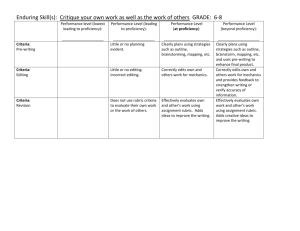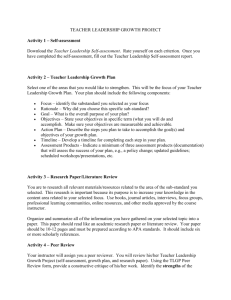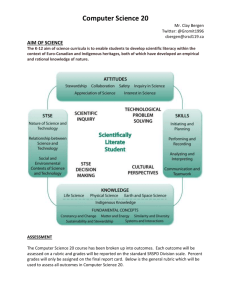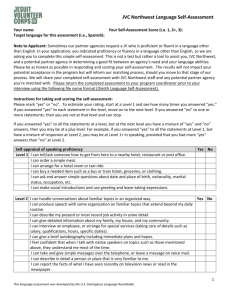Self-Assessment This completed worksheet provides and example
advertisement
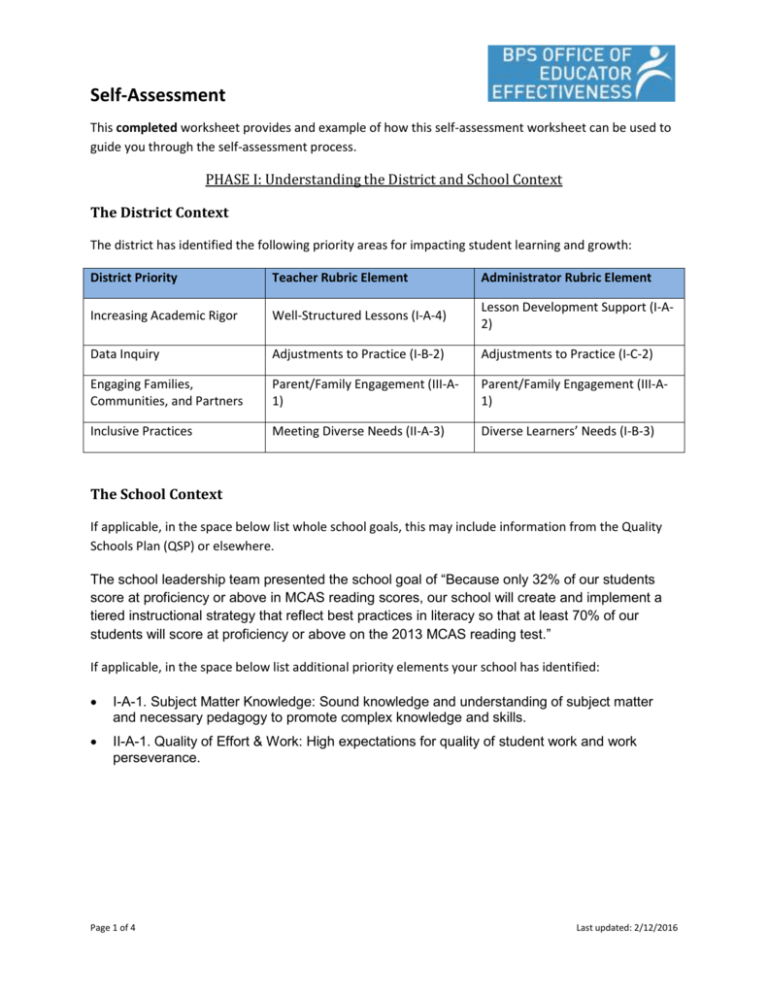
Self-Assessment This completed worksheet provides and example of how this self-assessment worksheet can be used to guide you through the self-assessment process. PHASE I: Understanding the District and School Context The District Context The district has identified the following priority areas for impacting student learning and growth: District Priority Teacher Rubric Element Administrator Rubric Element Increasing Academic Rigor Well-Structured Lessons (I-A-4) Lesson Development Support (I-A2) Data Inquiry Adjustments to Practice (I-B-2) Adjustments to Practice (I-C-2) Engaging Families, Communities, and Partners Parent/Family Engagement (III-A1) Parent/Family Engagement (III-A1) Inclusive Practices Meeting Diverse Needs (II-A-3) Diverse Learners’ Needs (I-B-3) The School Context If applicable, in the space below list whole school goals, this may include information from the Quality Schools Plan (QSP) or elsewhere. The school leadership team presented the school goal of “Because only 32% of our students score at proficiency or above in MCAS reading scores, our school will create and implement a tiered instructional strategy that reflect best practices in literacy so that at least 70% of our students will score at proficiency or above on the 2013 MCAS reading test.” If applicable, in the space below list additional priority elements your school has identified: I-A-1. Subject Matter Knowledge: Sound knowledge and understanding of subject matter and necessary pedagogy to promote complex knowledge and skills. II-A-1. Quality of Effort & Work: High expectations for quality of student work and work perseverance. Page 1 of 4 Last updated: 2/12/2016 Self-Assessment PHASE II: Analysis of Student Learning, Growth, and Achievement List any type of student learning, growth and achievement information or data available to you. DRA-II performance data from last year Conversations with teachers on the 3rd grade team 3rd Grade MCAS Reading and Math scores Based on the student information and data, what are the strengths of your incoming students? The DRA-II shows that most of my incoming students have strong reading foundations, including accuracy and fluency. According to their previous teachers, students enjoy reading fiction and creative writing. In 3rd grade overall, students have Reading and Math scores that are higher than the state average with Math (68% Proficient) slightly higher than Reading (62% Proficient). Based on the student information and data, what are high-priority concerns? 5/20 incoming students are ELLs and 5/20 have IEPs (mostly focused on literacy goals). Six have reading comprehension at the 2rd grade level and five have reading comprehension around the 3rd grade level according to the DRA-II. Students with weak reading comprehension also have weaker reading fluency. Students will need additional support to be reading and comprehending successfully at grade level by the end of the year. There are also four students reading above grade level as well, so instruction and materials in that area will need to be strongly differentiated. Now, based on your answers above, brainstorm some general goal topics that you may develop into a Student Learning Goal. Improving reading comprehension and fluency skills. Growth in reading levels. Literacy with students with IEPs. Page 2 of 4 Last updated: 2/12/2016 Self-Assessment PHASE III: Reflection on Previous Evaluation Feedback & Progress Toward Goals Consider the feedback on your progress towards goals from your most recent evaluation. What were your success and challenges in making progress towards your previous goals? Previous Goals Based on the fact that less than 5% of students in SEI currently recognize more than 20% of the taught Reading Street high-frequency words on the preassessment, my goal is that 85% of students will be able to recognize 85% of these words on the same assessment by June 1. In order to increase vocab recognition skills in my ELL students, I will use culturally proficient teaching materials, as measured by the images and languages I use in written instruction. I will measure my progress by reviewing all written material I will use at the beginning of each unit. Success and Challenges Successes: 85% students attained mastery a few weeks earlier than scheduled! Challenges: Mid way through the year the level of student engagement for high-frequency word lessons and assignments dropped. Successes: I had the most parental engagement from non-English speaking parents I have ever had, and I think this was attributable in part to my commitment to using images and languages that were accessible to parents in written materials. Challenge: My goal really pertained to cultural proficiency in terms of images and languages. I think that this might be even more meaningful if I worked on cultural proficiency in curricular content also. Consider the feedback on your proficiency in each of the standards from your most recent evaluation. What were your success and challenges in making progress towards your goals? Standards Standard I: Curriculum, Planning, and Assessment Successes and Challenges Standard II: Teaching All Students Standard III: Family and Community Engagement Standard IV: Professional Culture Page 3 of 4 Successes: All my units and lesson plans were designed with multiple forms of assessment. Challenges: I was not always sure how to best analyze student open response data. Successes: I differentiated lessons and assessment tasks to meet the needs of my students. Challenges: Same as SL goal Successes: Same as PP goal Challenges: Communicating expectations for long-term projects with parents. Successes: I met with colleagues pretty frequently to reflect on my practice. Challenges: Taking on leadership positions within the school. Last updated: 2/12/2016 Self-Assessment PHASE IV: Identifying Strengths and Areas of Growth Use the information from PHASES I, II and III to identify some of your specific strengths as an educator. Remember to link your strengths to specific a specific element. Educator Strength Former student MCAS data (achievement and growth) and benchmark data shows that I am successful at improving student performance in both Math and ELA for students who enter my class performing below grade level. I have also received positive feedback from my peers and principal regarding my ability to differentiate my instruction to meet diverse needs. I have also been successful at increasing communication and collaboration with parents, as evidence by increasing attendance to parent nights, homework workshops, and internet traffic to my classroom website. Aligned Element I-A-1. Subject Matter Knowledge II-A- 3. Meeting Diverse Needs III-C-1. Two-way Communication Use the information from PHASES I, II, and III to identify areas for growth that you would like to focus on and/or need support in. Educator Area for Growth I would like increased opportunities to serve as a mentor and model for my peers, and support in developing leadership skills. Aligned Element IV-B-1. Professional Learning and Growth I am also concerned that although my past performance with regard to Curriculum and Planning has been strong, I will face new challenges when we begin to implement the revised curriculum frameworks. I would like additional support in transitioning to the new frameworks. I-A-3. Rigorous StandardsBased Unit Design Our 4th grade team met to review the rubric and are collectively concerned about the implementation of the revised curriculum frameworks, and would like to have additional supports (time, PD, etc) to develop our skills with regard to unit design, backward mapping to the new standards, and assessments. I-A-3. Rigorous StandardsBased Unit Design NEXT STEP! Based on your strengths and areas for growth, brainstorm some general goal topics that you may develop into a Professional Practice Goal. Page 4 of 4 Last updated: 2/12/2016
